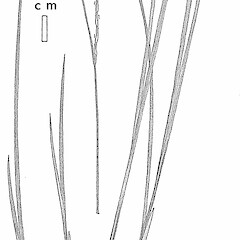Carex imbecilla
Common name
feeble bastard grass, hook sedge
Synonyms
Uncinia gracilenta Hamlin
Family
Cyperaceae
Flora category
Vascular – Native
Endemic taxon
Yes
Endemic genus
No
Endemic family
No
Structural class
Sedges
NVS code
The National Vegetation Survey (NVS) Databank is a physical archive and electronic databank containing records of over 94,000 vegetation survey plots - including data from over 19,000 permanent plots. NVS maintains a standard set of species code abbreviations that correspond to standard scientific plant names from the Ngä Tipu o Aotearoa - New Zealand Plants database.
UNCGRA
Chromosome number
2n = 88
Current conservation status
The conservation status of all known New Zealand vascular plant taxa at the rank of species and below were reassessed in 2017 using the New Zealand Threat Classification System (NZTCS) – more information about this can be found on the NZTCS website. This report includes a statistical summary and brief notes on changes since 2012 and replaces all previous NZTCS lists for vascular plants.
Please note, threat classifications are often suggested by authors when publications fall between NZTCS assessment periods – an interim threat classification status has not been assessed by the NZTCS panel.
- Conservation status of New Zealand indigenous vascular plants, 2017 . 2018. Peter J. de Lange, Jeremy R. Rolfe, John W. Barkla, Shannel P. Courtney, Paul D. Champion, Leon R. Perrie, Sarah M. Beadel, Kerry A. Ford, Ilse Breitwieser, Ines Schönberger, Rowan Hindmarsh-Walls, Peter B. Heenan and Kate Ladley. Department of Conservation. Source: NZTCS and licensed by DOC for reuse under the Creative Commons Attribution 4.0 International licence.
2017 | Not Threatened
Previous conservation statuses
2012 | Not Threatened
2009 | Not Threatened
2004 | Not Threatened
Distribution
Endemic. New Zealand: North Island (from about Whangarei south), South Island (Marlborough Sounds, northern Marlborough, Nelson, Otago, South Canterbury, Westland, Fiordland) and Stewart Island/Rakiura.
Habitat
Mostly montane forest, cloud forest or in subalpine scrub, often on or near rotting logs. Descending to coastal areas in the southern part of its range.
Detailed description
Loosely tufted, dark green or reddish-green plants. Culms 100–420 × c. 0.5 mm, glabrous or rarely scabrid below inflorescence; basal sheaths dark brown, shining. Leaves 4–6 per culm, usually > culm, 1.0–2.0 mm, wide, dark green or reddish green, margins moderately scabrid. Spikes 50–70 × c. 2 mm, usually bracteate, the bract leaf-like and far overtopping spike, or setose and shorter than spike, female flowers c. 15–20, ± equidistant in lower part of spike with internodes to 6 mm long, c. 2 mm apart above. Glumes < utricles, deciduous, acuminate, hyaline with green midrib. Utricles 4–5 × c. 1 mm, trigonous, elliptic-lanceolate or oblong, green, faintly nerved with the lateral nerves more prominent, scarcely spreading when ripe, stipe 1.0–1.5 mm long, beak c. 1 mm long.
Similar taxa
Distinguished from other species by the glossy (shining), dark brown, basal bracts and the short, (usually hidden amongst the leaves), lax-flowered spikes with ± equidistant utricles. Carex imbecilla shares with C. erebus K.A.Ford and C. aucklandica (Hamlin) K.A.Ford dark brown basal bracts, from both these species it is distinguished by the spikes which are greater than 50 mm long. Carex erebus is confined to the Subantarctic islands, and C. aucklandica the southern South Island, Stewart Island/Rakiura, Auckland Islands and Campbell Island/Motu Ihupuku. Carex imbecilla is potentially sympatric with only C. aucklandica, and only then in the very southern part of its range.
Flowering
October–December
Fruiting
November–April
Propagation technique
Easily grown from fresh seed and by division of established plants, though these may take a while to settle. Prefers moist soil in a a semi-shaded site.
Etymology
carex: Latin name for a species of sedge, now applied to the whole group.
imbecilla: Weak
Where To Buy
Not Commercially Available
Attribution
Fact sheet prepared for NZPCN by Peter J. de Lange 17 August 2006. Description adapted from Moore and Edgar (1970).
References and further reading
Moore LB, Edgar E. 1970. Flora of New Zealand, Volume II. Indigenous Tracheophyta: Monocotyledones except Gramineae. Government Printer, Wellington, NZ. 354 p.
NZPCN Fact Sheet citation
Please cite as: de Lange, P.J. (Year at time of access): Carex imbecilla Fact Sheet (content continuously updated). New Zealand Plant Conservation Network. https://www.nzpcn.org.nz/flora/species/carex-imbecilla/ (Date website was queried)


